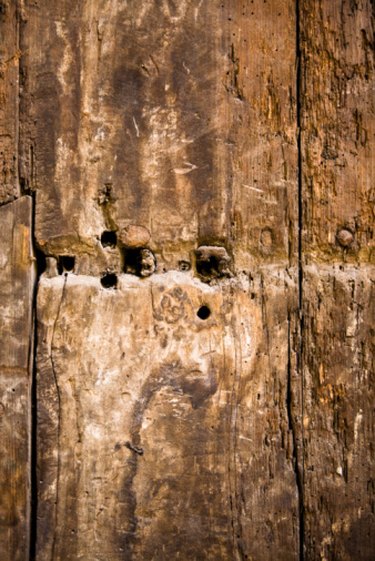Things You'll Need
Oil or acrylic paint
Paint palette
Palette knife
Canvas
Paintbrush
Mineral spirits (optional)
Rags

Canvas is a versatile artist's material that can be manipulated to look like nearly anything with the right application of either acrylic or oil artist's paint. Canvas has a variety of textures, ranging from very smooth to coarse. This makes creating textures from paint possible. One such texture is that of weathered wood, which is a great background for more complex pieces or a finished look for a soft, abstract piece. Create the look of weathered wood with typical art supplies and paint.
Step 1
Determine which type of paint you are going to use. Oil paints are heavy-textured and will need mineral spirits for thinning. Acrylics are typically less heavy and are water-based, which means they can be thinned with plain tap water.
Video of the Day
Step 2
Squeeze some burnt umber and white paint in separate dollops on the paint palette. With the palette knife, scoop up a small amount of the umber paint and place it in a separate area on the palette. Gradually add white paint to create a gradation of brown from the darkest brown to a mid-brown color. To add more warmth to the brown, add minuscule amounts of red or yellow paint.
Step 3
Paint a base mid-brown color onto the canvas, using a paintbrush. Keep the layer smooth and without any texture for the time being.
Step 4
Continue adding layers of paint in the various shades of brown you created on the paint palette. Don't get too technical; wood is a natural material and is not perfect, nor is it all the same color. When painting, use long, vertical strokes to emulate the different gradations found in wood.
Step 5
Dampen a rag with mineral spirits if you are using oil paint, or water if you are using acrylics. Keep in mind that acrylics dry very quickly; this must be done while the paint is still wet. Crunch the rag in your hand and drag it very lightly down the canvas in a vertical sweep. This will pick up some of the paint and leave the surface looking textured.
Step 6
Go back in with a very small brush and the midtone and dark-tone paint, creating vertical "wood grain" lines. These lines should not be perfectly straight. You can texture the lines by using short, swift brush strokes instead of one long line.
Step 7
Let the painting nearly dry if you are using oil paint. Repeat Step 5 to weather the piece even more, dabbing the painting instead of rubbing it. For acrylics, add a small drop of white paint to a cup of water. Paint on a light layer of the whitewash and rub it with a rag to further weather the piece.
Tip
Use a photograph of a piece of weathered wood as a reference. You can add three-dimensional texture to the piece if desired by applying paint in thicker layers.
Video of the Day